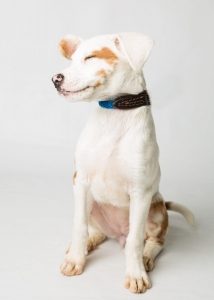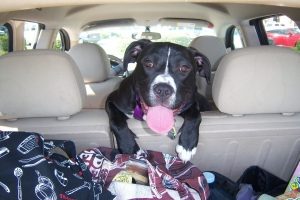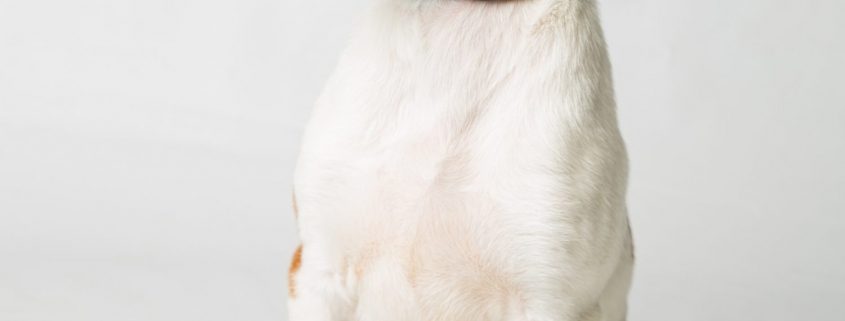Puppy Socialization: Pandemic Version, pt 2
Puppy Socialization During a Pandemic: What You Can Do

In our last post we discussed what socialization is, the developmental periods as a puppy grows, and the importance of learning to read a dogs body language. Now on to ways to work on socialization.
In some ways, social distancing can be a really good thing for some socialization. Trainers often suggest working at a distance and distance is built in at this time. Staying at a distance ensures that we can keep the dog under threshold and gently expose it to new stimuli. A lot of people misunderstand and think socialization is only about interacting with people but for some dogs that can be too overwhelming at first. Especially if you have a dog that leans towards the fearful side, exposing him to stimuli at a distance is the safest way to start socializing. Work towards developing self-confidence rather than flooding the dog with lots of people, noises and experiences.
Luckily, there is a lot that of socialization work that we can do at home or in the areas around the home that work on a variety of stimuli exposure. We want to expose the puppy to anything that we need him to be able to handle when he is an adult.
A dog needs to be able to calmly accept handling that it may experience in daily life.
If you are telecommuting at the moment, take the time now to prepare your puppy for being alone during the day. Separation anxiety is much easier to prevent than treat so teach your dog that being alone is actually great. Set up a puppy zone like a crate, pen or confined area and give your puppy fun interactive feeding toys and treats while you leave the puppy in the puppy zone. Start by just going to a different room and work up to actually leaving the house and run an errand or take a walk. Start at short increments like 15 minutes and work your way up to longer time periods.
A dog needs to be able to calmly accept handling that it may experience in daily life. Here are some ways to integrate that training at home.
- Think about each part of a vet exam or grooming session and include some form of that handling on a daily basis. Look in their ears, pick up their paws, look at their teeth, run your hands gently all over. Recreate the vet office by putting the puppy up on a counter or table and examining them. Each member of the family should spend time gently handling the puppy all over.
- Play family dress up. Dig in the attic and pull out your hats, coats, canes, crutches, umbrellas, Halloween costumes. You can start by just placing the item on the floor for your puppy to explore. Feed treats or put food on the item as he checks it out. Then try wearing the object or moving it around. Always pair the presentation of the object it with food and let the dog check things out at his own pace.
- Puppies also need to be exposed to different surfaces to walk on. Walk him around on different substrates in your yard such as pebbles, rocks, mulch, asphalt, grass, wet, dry surfaces. Pull out things from your kitchen or garage to walk on like fabric or cardboard.
- Play household noises either at a lower volume or have the puppy stand farther away. You can also play recordings of thunder or fireworks on the computer at a low volume. Play videos of people with other types of voices and accents through your speakers so your puppy can hear other people speaking.
- Take neighborhood walks if you are able to get enough space from people. If your puppy is not fully vaccinated, carry him around the neighborhood rather than walk him. If you have people that walk around in your neighborhood, you can stand at least 6 feet away and treat your puppy for looking at the people walking by or chatting with them.
- Expose your puppy to the sights and sounds of the streets. Stand far enough away from the street so that your puppy can see the traffic with getting scared. It is also good for them to see people riding bicycles, skateboards and any other wheels.
- Watch other dogs walking around from a distance. Watch your puppy for signs of fear or frustration. You may need to get further away and reinforce calm behavior while looking at the other dogs. Avoid approaching other dogs if you don’t know if they are friendly with puppies. A negative experience with another dog can have a long lasting effect on the puppy. If you have friends with puppy friendly dogs, you may be able to set up socially distanced puppy play dates in the backyard.
- After being stuck inside for weeks, experience the joy of a car ride with your puppy. Take your puppy for a drive past farms where they can see the cows or other farm animals. If you have errands where you can take the dog with you without having to leave him in the car bring him along. Take him to a supermarket and watch people walking around the parking lot from your car.
 For additional socializing ideas, check out one of our fantastic local Certified Professional Dog Trainers. We have some amazing trainers in our area, they may be offering socially distanced private lessons or online lessons. There are also some great online resources. Check out this socializing checklist from Dr Sophia Yin’s website for additional socializing ideas.
For additional socializing ideas, check out one of our fantastic local Certified Professional Dog Trainers. We have some amazing trainers in our area, they may be offering socially distanced private lessons or online lessons. There are also some great online resources. Check out this socializing checklist from Dr Sophia Yin’s website for additional socializing ideas.
If you have more questions about your pets behavior, feel free to reach out to us via our helpline with a call or text to (828) 393-5832 or Q&A form here. We are here to answer questions, provide support, and share resources that help you and your pet!







